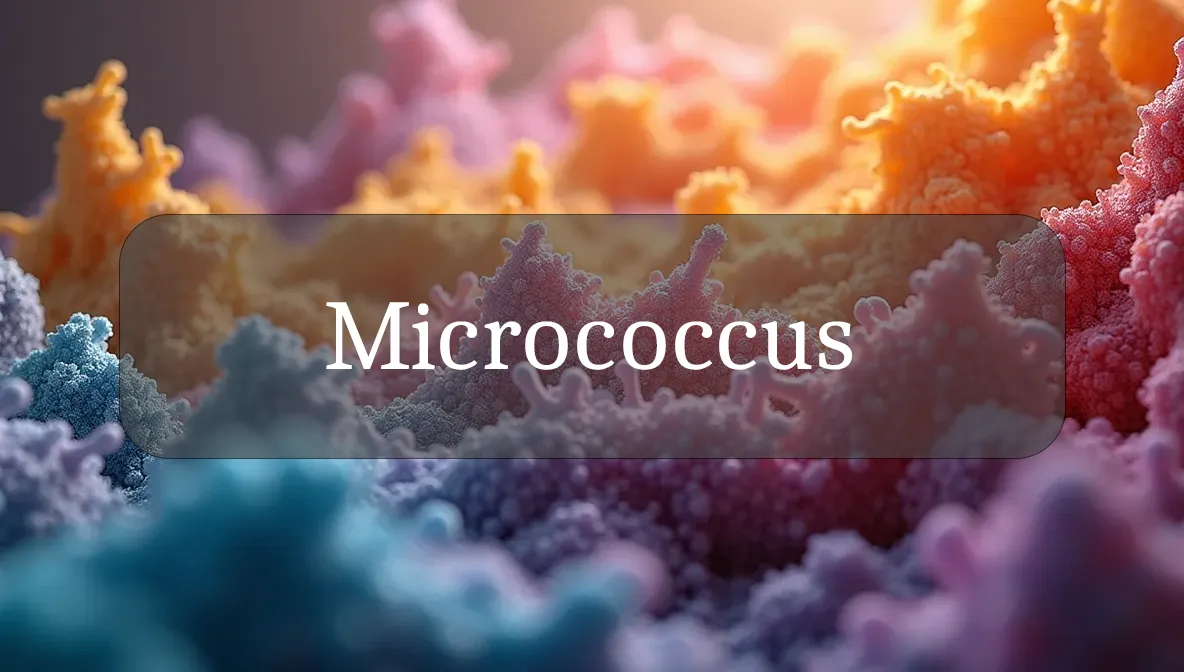Skin’s Gentle Bacterial Ally for Balance and Protection
Micrococcus is like a friendly guest on your skin, a group of bacteria that quietly contribute to your microbiome’s harmony. Found naturally on your skin and in the environment, these microbes are of interest to health-conscious folks aiming to maintain healthy skin and overall wellness. Understanding Micrococcus can empower you to make choices that support your skin’s ecosystem. Let’s explore what Micrococcus is, why it matters, and how you can nurture its role for daily vitality!
Chemical Identity and Type
Micrococcus is a genus of Gram-positive, spherical bacteria (cocci) that grow in clusters, belonging to the family Micrococcaceae. Common species include Micrococcus luteus and Micrococcus roseus. They are aerobic, thriving in oxygen-rich environments, and are non-motile, catalase-positive, and often pigmented (yellow or red). Found on skin, particularly in dry areas like arms or legs, and in soil, air, and water, Micrococcus is a resilient commensal microbe. Think of it as a colorful, protective tenant in your skin’s community, helping maintain balance.
Biological Role and Benefits
Micrococcus is a commensal bacterium that supports skin health when balanced, offering these benefits:
- Microbiome Diversity: It competes with harmful pathogens, preventing their overgrowth through colonization resistance, thus stabilizing the skin ecosystem.
- Antimicrobial Activity: Some Micrococcus species produce compounds that inhibit other microbes, protecting against infections.
- Skin Barrier Support: By maintaining microbial balance, it indirectly supports the skin’s pH and barrier function, reducing irritation or sensitivity.
- Environmental Adaptation: Its resilience to UV light and dryness helps protect skin in harsh conditions, contributing to resilience.
When balanced, Micrococcus fosters a healthy skin microbiome, enhancing overall vitality.
Dietary or Natural Sources
Micrococcus is a naturally occurring bacterium on human skin and in the environment, not sourced from food. However, you can support a healthy skin microbiome to maintain Micrococcus balance with these nutrient-rich choices:
- Probiotic-Rich Foods: Yogurt, kefir, and fermented foods (e.g., sauerkraut, kombucha) promote microbiome diversity, supporting Micrococcus’s role.
- Omega-3-Rich Foods: Fatty fish, walnuts, and flaxseeds reduce inflammation, fostering a balanced skin environment.
- Vitamin A-Rich Foods: Carrots, spinach, and sweet potatoes support skin cell turnover, complementing Micrococcus’s protective functions.
- Antioxidant-Rich Foods: Berries, green tea, and tomatoes protect skin from oxidative stress, enhancing microbial harmony.
A balanced diet promotes a diverse microbiome, keeping Micrococcus in check.
Signs of Imbalance or Dysfunction
An overgrowth or disruption of Micrococcus (rare, often in immunocompromised individuals or medical settings) may show up as:
- Opportunistic Infections: Skin infections, abscesses, or rashes, particularly in hospitalized patients with catheters or wounds.
- Systemic Infections (Rare): Bacteremia, endocarditis, or pneumonia in immunocompromised individuals, often linked to Micrococcus contaminating medical devices.
- Skin Irritation: Mild redness or sensitivity if Micrococcus overgrows due to microbiome disruption (e.g., from harsh soaps or antibiotics).
- Chronic Wounds: Delayed healing in rare cases where Micrococcus colonizes open wounds, especially in diabetic or bedridden patients.
These symptoms are uncommon and can have many causes, so consult a healthcare provider if they persist to explore skin or infection-related issues.
Supporting Optimal Levels or Function
To maintain a balanced Micrococcus population and promote skin health, try these evidence-based tips:
- Cleanse Gently: Use mild, non-comedogenic cleansers to preserve the skin microbiome. Avoid harsh soaps or alcohol-based products that disrupt Micrococcus balance.
- Eat a Balanced Diet: Include probiotic foods, omega-3s, and antioxidants to support microbiome diversity and reduce inflammation.
- Moisturize Regularly: Apply lightweight, microbiome-friendly moisturizers to maintain skin hydration, supporting Micrococcus’s protective role.
- Protect Skin: Use broad-spectrum sunscreen (SPF 30+) to shield skin from UV damage, which can disrupt microbial balance.
- Avoid Overuse of Antibiotics: Use antibiotics only as prescribed to prevent microbiome dysbiosis, which could allow Micrococcus overgrowth in rare cases.
Small, consistent habits foster a balanced skin microbiome, keeping Micrococcus in its beneficial role.
Safety, Interactions, and Precautions
Micrococcus is a natural part of the skin microbiome and generally safe, but consider these factors:
- Immunocompromised Individuals: Those with weakened immunity (e.g., HIV, cancer, or post-transplant patients) are at higher risk for Micrococcus infections, especially in hospitals.
- Medical Devices: Micrococcus can contaminate catheters, prosthetics, or IV lines, leading to infections like bacteremia (e.g., M. luteus is a common culprit). Proper hygiene reduces risk.
- Antibiotic Resistance: Some Micrococcus strains show resistance to antibiotics like penicillin or erythromycin, complicating rare infections. Sensitivity testing guides treatment.
- Skincare Products: Harsh cleansers or overuse of antibacterial products can disrupt Micrococcus balance, potentially leading to skin sensitivity or pathogen overgrowth.
Maintaining Micrococcus balance involves gentle skincare and supporting overall immunity.
Fun Fact
Did you know Micrococcus luteus can glow a sunny yellow on your skin? Its vibrant pigment not only adds color to the microbiome but also helps it resist UV light, acting like a tiny shield for your skin!
Citations
- National Institutes of Health (NIH): Skin Microbiome and Commensal Bacteria.
- Mayo Clinic: Skin Infections and Microbiome Health.
- Cleveland Clinic: Nutrition and Skin Wellness.
- World Health Organization (WHO): Diet and Skin Health Guidelines.
- USDA: Dietary Guidelines for Americans – Nutrient-Dense Diets.

